Parasite modelling: The Scottish Association of Marine Science (SAMS) recently advertised for a PhD student to develop a prototype forecasting tool for parasite abundances. The aim is to link outputs from a number of different computer models including those for coastal currents, sea lice dispersal and lice populations on farms. We are surprise that given the commercial implications of such a model that the task of developing this tool has been left to a research student. We have previously expressed our doubts about the increasing reliance now being placed on models for the determination of the impacts of lice on the environment. These models always depend on the assumptions on which they are based. Most research involving sea lice has been built on the assumption that sea lice do have an impact on the environment and especially wild fish, even though the evidence is extremely thin on the ground.
The details of this particular research studentship were outlined on the SAMS website and began with an overview; the first line of which is that ‘Parasitic sea lice pose a persistent challenge to the salmon aquaculture industry in all regions in which it operates with ecological impacts’. The overview then gives the reference to the scientific paper – Ford & Myers (2008). This paper is titled ‘A Global Assessment of Salmon Aquaculture on Wild Salmonids’ and comes from researchers at Dalhousie University in Halifax, Nova Scotia, Canada.
The part of the paper’s abstract of interest states:
We compared marine survival of salmonids in areas with salmon farming to adjacent areas without farms in Scotland to estimate changes in marine survival concurrent with the growth of salmon aquaculture. Through a meta-analysis of existing data, we show a reduction in survival or abundance of Atlantic salmon in association with increased production of farmed salmon. These reductions in survival or abundance can be greater than 50%. Meta-analytical estimates of the mean effect are significant and negative suggesting that salmon farming has reduced the survival of wild salmon.
We would point out that the study also looked at sea trout, Pink, Chum and Coho salmon in Ireland and the Pacific and Atlantic coasts of Canada. However, it is the impacts of salmon farming on wild salmon in Scotland that will be considered here.
By referring to this paper, SAMS clearly imply that salmon farming in Scotland is having a negative impact on wild fish. By comparison, we, at Callander McDowell, do not believe that this paper shows any such impact in Scotland at all.
The authors compared rod catches of salmon from Scotland’s east coast with those from the west coast for the years 1971 to 2004. They say that salmon farms ‘appear to be’ located in the majority of bays in the west coast so all rivers on that coast were placed in a group they labelled ‘exposed’. They say that as there is no salmon farming on the east coast, that coast was used as the control. They also say that farmed salmon production for all of Scotland was used in their modelling because no regional data was available!!! The explanation marks are ours.
The graph that Ford & Myers included in their paper comparing rod catches from east (black) and west coast rivers (blue) with farm production (red) is reproduced below.
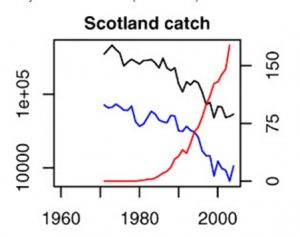
The authors state that they have detected a significant decline in survival of populations that are exposed to salmon farms correlated with the increase in farmed salmon production. They relate that in regions such as Scotland where the declines precede that start of salmon farming, the strong aquaculture effect estimated reflects a faster decline in exposed populations concurrent with the growth of salmon farming.
These conclusions are based on a variety of statistical analyses and models; however, we prefer to look at the evidence provided by the graph. What is clear is that both east coast (black) and west coast (blue) catches have been in decline since the 1970s. Although statistics will undoubtedly show otherwise, it does look very much like the declines are in parallel. West coast catches are less than those on the east coast because of the very different nature of the rivers and also the fact that the fishing season is consequently much shorter. Recently, the east coast rivers accounted for over 80% of the Scottish catch with the west contributing the remainder. This means that there is likely to be an imbalance in any comparison but as the graph shows the rate of the decline for each coast is noticeably different.
Interestingly, Marine Scotland Science also refer to Ford & Myers on the Scottish Government website within their summary of the science behind aquaculture interactions with wild fish. They say that Ford & Myers compared indices of salmon abundance on the east and west coasts of Scotland together with farm production data and found a reduction in the catches of salmon on the west coast correlating with increased production of farmed salmon. MSS however fail to mention that declines in east coast catches also are likely to correlate with increased farm production. We would like to reproduce the graphs to demonstrate such a correlation with the east coast, but Ford & Myers do not describe the exact data they use.
More importantly, whilst MSS quote the Ford & Myers paper, they also state in their document ‘Using Catch Data to Examine the Potential Impact of Aquaculture on Salmon and Sea Trout’ that:
It is very important to note that analyses of fishery catches such as these cannot be used to prove whether or not fish farming has an impact on wild fish as there are many other factors that may cause changes in fish populations and may differ between the regions of coast that were considered. For example, catches of sea trout have declined over recent decades on both farmed and non‐farmed areas in Scotland and it is plausible that different factors are responsible in the two regions.
We find it really strange that if analysis of catch data such has been undertaken by Ford & Myers (with data supplied by Marine Scotland Science (or its former incarnation)) cannot be used to determine whether salmon farming has an impact on wild fish numbers, why Marine Scotland Science are quoting the paper in its summary of the science behind the impacts of salmon farming on wild fish at population level. Perhaps, it was just a coincidence that Marine Scotland Science published their catch data comparison document only when faced with a new analysis of catch data that didn’t support the view that salmon farming has an impact on wild fish populations. Marine Scotland Science also fail to offer a possible explanation that if west coast declines are due to salmon farming as to what might be causing the decline on the east coast. More likely is that the declines across Scotland are for the same reason and that salmon farming isn’t the guilty party as might be suggested.
Ford & Myers did not just compare catches from the east and west coast, they also compared data from fish counters. Marine Scotland Science say that the paper shows that the impact of sea lice in other countries is of similar magnitude to the difference between the aquaculture zone (west coast) and the east coast as determined using data from fish counters. They say that they do not know how much of the regional variation may be due to factors other than aquaculture.
Ford & Myers compared data from east and west coast counters, however whilst they compiled data from ten counters on the east coast, they used only two on the west. The ten east coast counters were on the following rivers: Aigas, Beanna, Torr Achilty, Dundreggan, Invergarry, Logie, Westwater, Cluni, Erich, and Pitlo. The west coast counters are the Awe Barrage, which they say empties into a bay with numerous salmon farms. The other is at Morar, which they say is less than 20 km from the nearest salmon farm. Their graph comparing the counts from both coasts also shows farmed salmon production.

Ford & Myers don’t particularly comment on the count data specifically however what is immediately apparent is the decline in counts from the two west coast counters (blue) occurred long before salmon farming became really established. After 1990, the pattern of counts from both coasts look remarkably similar.
As the west coast counts originate form two counters, it is possible to look at these separately.
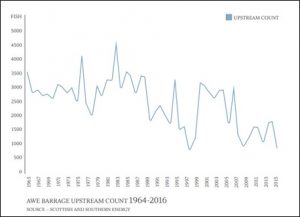
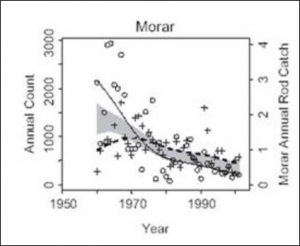
The Morar count is the thinner grey line that begins at the highest point. The Morar shows a sharp decrease in the count before 1980 and then the decline slows down at a time when salmon farming becomes established. Although there are significant fluctuations, the Awe counter shows a decline from the date it was installed, again long before salmon farming arrived in the vicinity.
We have previously shown that sea trout catches have also been in decline since catch data was first recorded. We have yet to understand the reasons behind this decline.
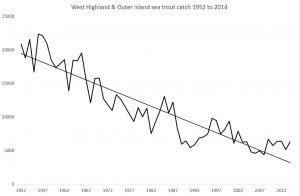
Sea trout catches have declined by about 75% since 1952 with a 40% decline until the arrival of salmon farming. We can see from the Scottish Government website that Marine Scotland Science have expressed their view of the science behind the reason why they believe sea lice from salmon farms have a negative impact on wild fish stocks. This is because through the catch data they collect they can see that catches have declined along the west coast. What is surprising is that Marine Scotland Science (or their former incarnations) have been collecting this data since 1952 and must have equally been aware that salmon and sea trout stocks were in decline. Yet, surprisingly, there seems to have been no investigation or enquiry as to why fish stocks were in decline during the time before the arrival of salmon farming. It was only the presence of salmon farming that seems to have initiated an interest in finding the cause of the ongoing decline. Why fish stocks were in decline prior to the arrival of salmon farming remains a mystery.
We would argue that it is just not acceptable that the reasons for theses historical declines remain unknown since it is quite possible that whatever caused the declines then are still responsible for the declines now. In our opinion, Marine Scotland Science remain completely uninterested. After all salmon farming is a much more convenient scapegoat.
Another question: The Norwegian Aquablogg.no raises an interesting issue about the impacts of sea lice from salmon farms on wild fish. The wild fish lobby have always maintained that the real damage to salmon and sea trout occurs when young migrating smolts swim out into the fjords past salmon farms that are alegedly rife with lice. These young fish are easily susceptible to attack by high numbers of lice and hence quickly succumb. The resulting mortality means that less fish return to breed in subsequent years ensuring a vicious circle that has brought about a massive decline in salmon and sea trout stocks.
However, Aquablogg has reviewed seven years of weekly lice counts and found that very few salmon farms have exceeded the lice limit during the important weeks of smolt migration. They have produced the following graph that shows the number of farms exceeding the limit at various times of the year.
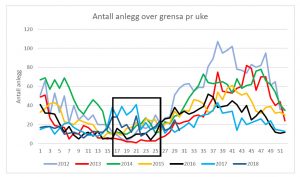
Salmon farms may experience higher lice counts later in the year but as Aquablogg points out, this is a problem for the farm, not for wild salmon as the young fish will have long left coastal waters for the feeding grounds.
Aquablogg also refers to an article on Kyst.no which examined all the parameters for lice for one week – week 13. This occurred at the end of March crossing into the beginning of April. Kyst looked at the adult female lice levels for that week for every year since 2002 and displayed their findings on the following graph:
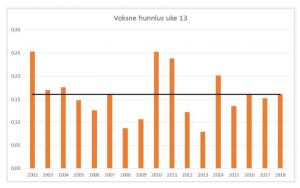
It can be seen that for 13 out 17 years from 2002, lice levels were below 0.2 adult females with an average of 0.16. The highest reading for the other four years was about 0.25. These figures confirm that there was minimal risk to wild fish during this important time.
Aquablogg suggests that perhaps the focus on wild stocks is misplaced. In 2017, the lice limit was reduced from 0.5 adult female lice to 0.2 but as can be seen, this will have had almost no impact because actual lice levels were already well below the new limit.
Of course, this is of no surprise. As we have repeatedly suggested, it is easier to blame salmon farmers for the decline in wild fish than look for the real reasons.
What’s the mystery: The Sunday Times reported the latest in-depth investigation conducted by the salmon angler’s representatives, Salmon & Trout Conservation Scotland (STCS). This took the form of yet another Freedom of Information request to ask the Scottish Government for clarification about alleged escapes from salmon farms. S&TCS had asked questions about the fate of 300,000 fish from one specific incident in 2016.
S&TCS say that the Scottish Government has acknowledged for some time that ‘escapes from fish farms are a cause for concern for conservation and wild fish interests’. We at Callander McDowell, agree that there are concerns about the conservation of wild fish but wonder why the Scottish Government have yet to take decisive action to safeguard the future of wild salmon and grilse. We are unable to include any data from 2018 because this won’t be published until well into 2019 even though data is recorded on a daily basis, but for the years 2016 and 2017, 1,570 salmon and grilse have been caught by anglers using rod and line from rivers within the aquaculture zone. Of these just 39 (18 salmon and 21 grilse) were of alleged farmed origin. This is only alleged because it is up to the individual angler to decide whether the fish is from a farm or not. We are not aware that samples have to be retained and sent for analysis.
Of the 451 salmon and 1080 wild salmon and grilse caught by anglers, 344 salmon and 764 grilse were released back into the river with the remaining 107 salmon and 316 grilse being killed and kept for the pot. Given that the angling sector have been claiming that the wild fish stocks along the west coast are in terminal decline, it is rather surprising that 423 wild salmon and grilse have been killed just for the sport.
If escaped farmed salmon are such a threat to wild stocks, surely many more would have been caught in west coast rivers but in two years the number is less then 40 whilst over 400 wild fish have been prevented from breeding and they say farmed fish are the biggest threat.
On target: Salmon Business relates how the Minneapolis and St Paul Business Journal has revealed that the US retailer Target Corp has resumed selling farmed salmon in its stores, eight years after the store decided to sell only ‘sustainable’ wild caught salmon. At the time, their decision drew praise from a number of environmental groups.
Target have now said that farmed salmon can be sustainable too and have put it back on their shelves. In their review of the retail sector – Carting Away the Oceans’ , Greenpeace have criticised Target. They say that:
Since 2010, Target had one constant source of pride: unlike every other profiled retailer, it never buckled under industry pressure to sell farmed salmon, instead carrying only sustainably caught wild salmon. Until now. Since the last survey Target has quietly begun selling farmed salmon once again. Industrial farmed salmon is a dirty business, and unfortunately Target is once again a customer.
It is interesting that Greenpeace say that Target have buckled under industry pressure because this is not how we perceive their change of heart. Rather than it being industry pressure, we would suggest that the pressure came from the customer or more likely the lack of customers. Farmed salmon has become central to fish sales in many countries. The absence of farmed usually results in a drop of sales because many consumers do not see other fish species – even wild Pacific salmon – as being an acceptable alternative. This means that if farmed salmon is not available, shoppers simply don’t buy fish. We believe that, although it has taken some time, Target have found that in the long-term, the removal of farmed salmon from its offering was just not a viable decision commercially.
We are not surprised that Greenpeace have put a different spin on Target’s choice to stock farmed salmon again. Suggesting that Target has buckled under industry pressure supports their negative perception of salmon farming and that image fits in with their stated agenda.


